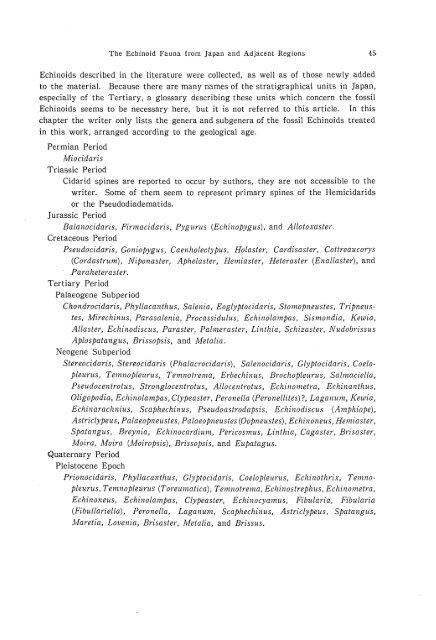the echinoid fauna from japan and adjacent regions part i
the echinoid fauna from japan and adjacent regions part i
the echinoid fauna from japan and adjacent regions part i
You also want an ePaper? Increase the reach of your titles
YUMPU automatically turns print PDFs into web optimized ePapers that Google loves.
The Echinoid Fauna <strong>from</strong> Japan <strong>and</strong> Adjacent Regions 45<br />
Echinoids described in <strong>the</strong> literature were collected, as well as of those newly added<br />
to <strong>the</strong> material. Because <strong>the</strong>re are many names of <strong>the</strong> stratigraphical units in Japan,<br />
especially of <strong>the</strong> Tertiary, a glossary describing <strong>the</strong>se units which concern <strong>the</strong> fossil<br />
Echinoids seems to be necessary here, but it is not referred to this article. In this<br />
chapter <strong>the</strong> writer only lists <strong>the</strong> genera <strong>and</strong> subgenera of <strong>the</strong> fossil Echinoids treated<br />
in this work, arranged according to <strong>the</strong> geological age.<br />
Permian Period<br />
Miocidaris<br />
Triassic Period<br />
Cidarid spines are reported to occur by authors, <strong>the</strong>y are not accessible to <strong>the</strong><br />
writer. Some of <strong>the</strong>m seem to represent primary spines of <strong>the</strong> Hemicidarids<br />
or <strong>the</strong> Pseudodiadematids.<br />
Jurassic Period<br />
Balanocidaris, Firmacidaris, Pygurus (Echinopygus) , <strong>and</strong> Allotoxaster.<br />
Cretaceous Period<br />
Pseudocidaris, Goniopygus, Caenholectypus, Holaster, Cm'disaster, Cottreaucorys<br />
(Cordastrum), Niponaster, Aphelaster, He71liaster, Heteraster (Enallaster) , <strong>and</strong><br />
Paraheterastei'.<br />
Tertiary Period<br />
Palaeogene Subperiod<br />
Chondrocidaris, Phyllacanthus, Salenia, Eoglyptocidaris, Stomopneustes, Tripneustes,<br />
Mirechinus, Parasalenia, Procassidulus, Echinolampas, Sismondia, Kewia,<br />
Allaster, Echinodiscus, Paraster, Palmeraster, Linthia, Schizaster, Nudobrissus<br />
Aplospatangus, Brissopsis, <strong>and</strong> Metalia.<br />
Neogene Subperiod<br />
Stereocidaris, Stereocidaris (Phalacrocidaris), Salenocidm'is, Glyptocidaris, Coelopleurus,<br />
Temnopleurus, Temnotrema, Erbechinus, Brochopleurus, Salmaciella,<br />
Pseudocentrotus, Stronglocentrotus, Allocentrotus, Echinometra, Echinanthus,<br />
Oligopodia, Echinolampas, Clypeaster, Peronella (Peronellites)?, Laganum, Kewia,<br />
Echinarachnius, Scaphechinus, Pseudoastrodapsis, Echinodiscus (Amphiope) ,<br />
Astriclypeus, Palaeopneustes, Palaeopneustes (Oopneustes), Echinoneus, Hemiaster,<br />
Spatangus, Breynia, Echinocardium, Pericosmus, Linthia, Cagaster, Brisaster,<br />
Moira, Moira (Moiropsis) , Brissopsis, <strong>and</strong> Eupatagus.<br />
Quaternary Period<br />
Pleistocene Epoch<br />
Prionocidaris, Phyllacanthus, Glyptocidaris, Coelopleurus, Echinothrix, Temnopleurus,<br />
Temnopleurus (Toreumatica), Temnotrema, Echinostrephus, Echinometra,<br />
Echinoneus, Echinolampas, Clypeaster, Echinocyamus, Fibularia, Fibularia<br />
(Fibullariella) , Peronelia, Laganum, Scaphechinus, Astriclypeus, Spatangus,<br />
j'v/aretia, Lovenia, Brisaster, Metalia, <strong>and</strong> Brissus.












